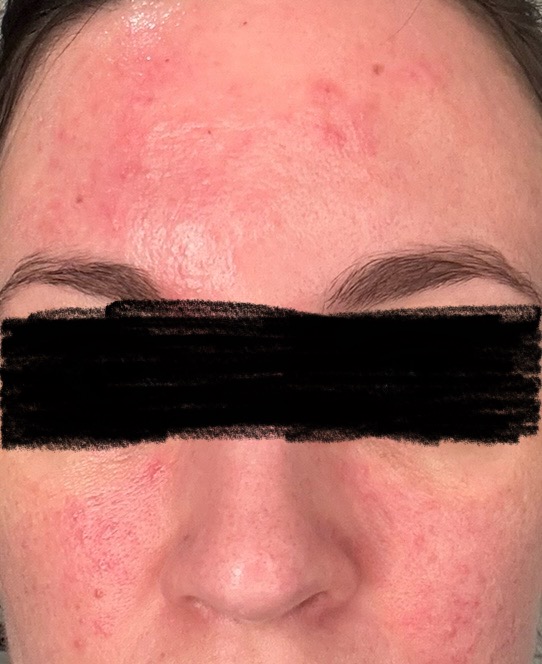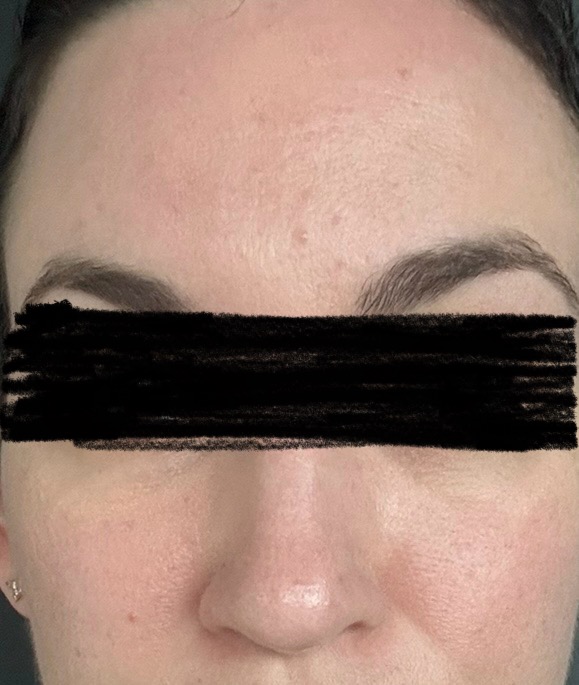For years, I battled what I thought was stubborn acne. No matter how many cleansers, spot treatments, or exfoliants I tried, those tiny bumps on my forehead and cheeks never went away. They would get better and then worse again.
I had gone to 3 different dermatologists, all diagnosing me with a different skin condition. Rosacea, seborrheic dermatitis, acne… you name it. After my pregnancy the flares got even worse so I even got prescribed Accutane (more on that in another post)! I was so frustrated with my skin, borderline depressed. Because it was so irregular – tiny bumps everywhere; my make up couldn’t cover it up.
To be fair, I probably do have a mild form of rosacea, but nothing really helped my redness (topical creams and azelaic acid never changed anything for me), I never figured out my triggers – apart from stress. But I knew deep inside that rosacea wasn’t what was happening to my skin.
After way too much frustration (and late-night Googling and asking away at ChatGPT), I finally discovered (what I can now say is) the truth: it wasn’t acne at all. It was fungal acne. And now when I look back I’m not sure to be mad or happy how easy it was to get my skin into an almost perfect condition in less than one month! After 10 years of trying!
My before and after:


I shared my story with my friends, and won’t you know it – one friend of mine also had the same problem for a few months and it helped her too!
I’m keeping my fingers crossed that this might help you the way it worked for me. This post contains affiliate links (no extra charge to you!) to the products I now use every day and I can’t (and won’t) live without. I am a sucker for Korean skincare so most recommendations are not Western 😀
I will share a bit about fungal acne and my story at first and get to my routine at the end.
🌱 What is Fungal Acne?
Despite its name, fungal acne isn’t really acne. The technical term is Malassezia folliculitis, and it happens when yeast (which naturally lives on our skin) grows a little too much and clogs hair follicles.
Unlike regular acne caused by bacteria, oil, and clogged pores; fungal acne is fueled by yeast—and that’s why your usual acne treatments don’t work. In fact, some products may make it worse!
🌱 How to Tell If It’s Fungal Acne
Here are some signs that helped me figure it out:
- Small, uniform bumps: Unlike typical acne which varies in size, fungal acne looks like clusters of tiny pimples. They are usually present on the forehead cheeks, shoulders and back.
- Itchy or prickly feeling: Sometimes it feels more irritating than painful. I, however, had no itchiness!
- No improvement with acne products: In fact, creams that are too oily or heavy can make it flare up.
- Hot showers and hot climate will make it worse.
- They might appear or worsen after any kind of antibiotic treatment (which will affect the skin flora balance)
🌱 What Actually Helped Me
Once I realized what it was, I changed my approach completely. I was doing everything wrong. I had hot showers, I wanted to ‘feed’ my dehydrated skin with rich creams (only feeding the yeast!), traveled to the tropics, had 5 antibiotic treatments in the last 10 years due to bladder infections… and the list goes on.
Here’s what made the difference:
0. Going through my bathroom cabinet
I religiously stopped using ANYTHING that was fungal acne unsafe… turns out I had a lot of products that I wasn’t supposed to use! I helped myself with ChatGPT (I’m not afraid to say, although I do know a lot about skincare ingredients but it’s much quicker that way) and I think you should too. Once you don’t have the damning products there anymore, it’s time for treatment.
1. Anti-fungal ingredients
Dandruff shampoo – YES! This is your saviour! The Ketonazole will kill away the yeast. I used Nizoral and my instructions are – use it as a mask every morning for 10 minutes. Then wash it away. Do this until your skin gets better (approximately 2 weeks), then use it once a week.
2. Anti-acne treatment
I know FA isn’t acne – but what helps both is benzoyl peroxide. I used it every other day again as a face mask in the evening for 2 hours (I used the 5% cream), but you can use it in cleanser form! I kind of had a better feeling if I could leave it on the skin for longer.
3. New Skin Routine
I think I majored in fungal-acne safe skin routine. I did extensive research, read all the forums and consulted specialists (other dermatologists that didn’t treat me before :D) so I will share with you my favourites at the end of my post.
4. Patience
I think I was always very patient with my skin. I understood that sometimes it takes 3 months to see a difference. But for me, I was positively surprised at what I achieved in mere 2 weeks! Yes, it doesn’t clear overnight, but once I treated the cause instead of the symptoms, the bumps finally started fading. By the first month I can say my skin never looked better (in the last 10 years).
🌱 My Fungal Acne Safe Skin Routine
This routine (apart from someone having FA) is targeted more for sensitive and dry type of skin. I do have recommendations for all kinds of skin on my Benable account (my code is B2YR7).
AM routine
Cleanser: B : Lab – Matcha Hydrating Foam Cleanser (non-exfoliation, can be used everyday) or Cetaphil Gentle Cleanser
Toner: Anua Hearleaf 77% Soothing toner
Serum: Anua Azelaic acid soothing serum
Moisturizer: La Roche Posay Toleriane Sensitive Fluide (You need this one, not the creme – it’s without yeast feeding oils ;)) or Dr.G – R.E.D Blemish Clear Soothing Cream
Sunscreen: La Roche-Posay Anthelios Sunscreen SPF 50 or Rohto Mentholatum – Skin Aqua SPF50+
PM routine
Double cleansing: first cleansing oil – Skin1004 Centella Light Cleansing Oil and the cleanser: B : Lab – Matcha Hydrating Foam Cleanser (non-exfoliation, can be used everyday) or Cetaphil Gentle Cleanser
Toner: Anua Hearleaf 77% Soothing toner
Serum: dr. Althea Fungal Acne Safe C vitamin Serum
Moisturizer: La Roche Posay Toleriane Sensitive Fluide or Dr.G – R.E.D Blemish Clear Soothing Cream
🌱 Key Takeaway
If you’ve been struggling with stubborn “acne” that doesn’t respond to normal treatments, it might be fungal acne instead. Don’t worry – you’re not alone, and with the right approach, it’s completely manageable.
And one more thing: if you’re unsure, it’s always best to check with a dermatologist. I know I just wrote a whole post about how I got wrongly diagnosed, but maybe you can ask them about fungal acne and you can find a solution together!
You can check the whole list on my Benable account (my code to join: B2YR7): FA safe skin routine and FA safe serums.
✨ Have you ever dealt with fungal acne without realising it? Share your experience in the comments – I’d love to know I wasn’t the only one who thought I had acne when it was something totally different.
